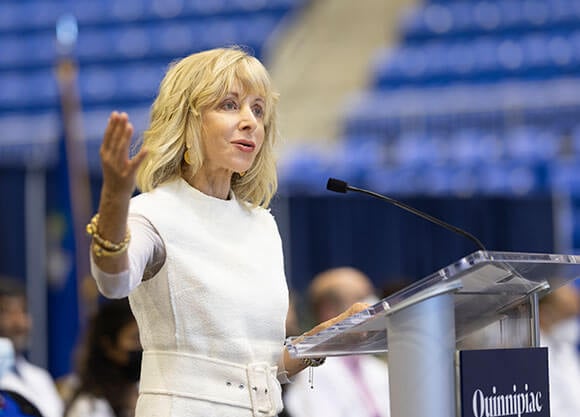
What’s the future of college athletics?
The perspective of a mid-major university
August 24, 2022

August 24, 2022

The Supreme Court ruling, a myriad of state laws, lack of direction from the NCAA and the subsequent ‘creative’ responses of programs, student-athletes and supporters have already upended the landscape for collegiate sports in countless ways.
Many of us are wondering where the Division I college athletics model will end up. While I don’t have a crystal ball, a possible scenario is that the Power Five schools spin out to compete in their own division, with their own governance structure and rules. And that’s why the rest of us who lead the ‘mid-majors’ need to consider what that means for us.
I spent my career at universities that are proud members of the Power Five before I moved to Quinnipiac University, a ‘mid-major’ Division I program. At QU we are among the 285 of the 350+ Division I programs which do not compete at the Power Five level. Quinnipiac’s 21 Division I varsity athletic programs bring tremendous value to our university and are a rallying point for our students and student-athletes, alumni and employees.
We invest in athletics because of our pride in the student-athlete academic model, the leadership roles these students play on campus, the reputational benefits derived from our sports programs, and the esprit de corp and stature that are achieved through Quinnipiac Athletics. We invest also in 21 club sports programs that are a natural extension of our Division I teams, that engage many students in high level, healthy and fun competitive sports across a variety of inter-university leagues.
There are fundamental differences between the funding of mid-major Division I programs compared to the Power Five. At Quinnipiac, for example, we spend substantial university operating funds supporting athletics, but receive a negligible NCAA distribution of funds to offset expenses. We don’t generate surplus revenues that might be shared with student-athletes through collective bargaining. We don’t have ‘collectives’ that will pay our student-athletes for appearances, endorsements, social influence campaigns or business investments. We don’t have coaches on multi-million-dollar contracts. And only a handful of our student-athletes continue to a professional sports career. Our focus is on ensuring that our student-athletes thrive on campus through their very positive academic and student life experiences.
Quinnipiac is a member of the Metro Atlantic Athletic Conference (MAAC), and I’m proud that our conference peer, St. Peter’s University, became the Cinderella story of this year’s NCAA Men’s Basketball Tournament, advancing to the Elite Eight before being knocked out. But with the deepening divides emerging among Division I teams, will it be possible for a ‘mid-major’ to make another Elite Eight run, to compete with the well-resourced programs, and now the well-funded athletes, of the Power Five?
There are numerous issues that now are up in the air regarding college athletics. One area that I believe we can agree on is the need for a single set of guidelines rather than a state-by-state patchwork, to govern Name, Image & Likeness (NIL) opportunities for student-athletes. While the NCAA has made some attempt to ensure that NIL deals are not inducements, the combination of the transfer portal and the emergence of collectives is ripe for abuse. The decision in the Alston case that validated educational benefits for student-athletes, above and beyond their scholarship and cost of attendance, may be just the beginning.
The transfer portal offers deserved flexibility to student-athletes, but at the cost of constantly churning rosters and more uncertainty. Collective bargaining may have a place in a few programs that generate large excess revenues from broadcast rights and sponsorship deals. Yet, it has the potential to jeopardize the student-athlete experience for the majority of Division I athletes and teams which do not compete in the top-tier programs or sports, particularly the more vulnerable women’s sports as well as more specialized Olympic sports.
The dust has not yet settled on these issues. Yet, we can already see that an inevitable divide is emerging between the handful of big-time, revenue-generating programs participating at the top of Division I, and the vast majority of schools who self-fund their athletic programs. The reality is that some student-athletes among the high-profile sports in the Power Five programs have become quasi-professional athletes, competing with—and against—the majority who are true amateurs.
If indeed the Power Five break away from Division I, we must grapple with some essential questions, and I’ll frame them from the perspective of a mid-major: Will there be an organization to stage national championships? Uniformity of rules among the ‘mid-major’ conferences? Competition with schools with whom we no longer share governance?
These questions loom with some urgency if the Power Five separate from the majority of Division I programs. We may be looking at a new model in which these select schools enjoy the elevated competition and rewards of ‘paid’ collegiate sports, while the rest of us preserve the ideals and joys of the true amateur model of college athletics.
Quinnipiac Today is your source for what's happening throughout #BobcatNation. Sign up for our weekly email newsletter to be among the first to know about news, events and members of our Bobcat family who are making a positive difference in our world.
Sign Up Now